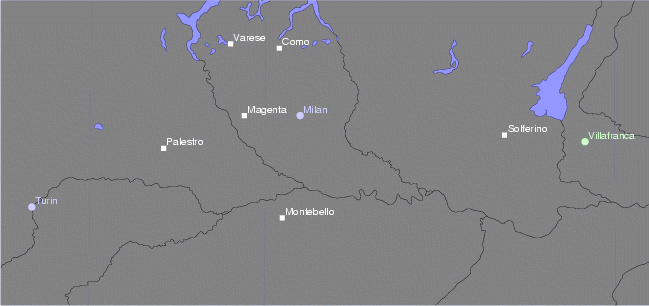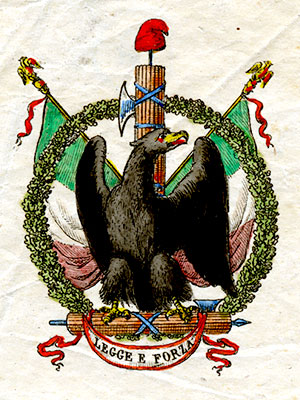|
Luigi Mezzacapo
Luigi Mezzacapo (Trapani, 25 January 1814 – Rome, 27 January 1885) was an Italian general, patriot and politician. Youth He attended the Nunziatella Military School between 1825 and 1832 where his brother :it: Carlo Mezzacapo, Carlo, Giuseppe Salvatore Pianell and Enrico Cosenz were among his classmates. When he graduated he became an artillery officer in the army of the Kingdom of the Two Sicilies. First War of Independence Appointed captain in 1847, in 1848 he was part of the expeditionary force of 15,000 men that the constitutional government of Carlo Troya sent to Lombardy, under the command of Guglielmo Pepe to help the Kingdom of Sardinia in the First Italian War of Independence. After the recall of the expeditionary force by Ferdinand II of the Two Sicilies, King Ferdinand II Luigi Mezzacapo joined his brother Carlo and numerous other soldiers of the Sicilian army including Guglielmo Pepe, Enrico Cosenz, :it:Cesare Rosaroll, Alessandro Poerio and :it:Girolamo Calà Ulloa ... [...More Info...] [...Related Items...] OR: [Wikipedia] [Google] [Baidu] |
Minister Of War (Italy)
The minister of war of Italy (), was the minister responsible for the Ministry of War (Italy), Ministry of War, which in turn oversaw the Royal Italian Army under the Kingdom of Italy between 1861 and 1946 and the Italian Army under the Italian Republic from 1946 to 1947. The position was abolished in 1947 when the Ministry of War, Ministry of the Navy (Italy), Ministry of the Navy, and Ministry of Aeronautics were merged to form the Ministry of Defence (Italy), Ministry of Defence under the oversight of the new position of Minister of Defence (Italy), Minister of Defence. The first minister of war was Manfredo Fanti, a General officer, general of the Royal Italian Army, while the last one was Cipriano Facchinetti, a member of the Italian Republican Party. The longest-serving minister was the Italian fascist, fascist dictator Prime Minister of Italy, Prime Minister Benito Mussolini of the National Fascist Party. List of ministers Kingdom of Italy ; Parties * ** ** * ** ** ** ** ... [...More Info...] [...Related Items...] OR: [Wikipedia] [Google] [Baidu] |
Manfredo Fanti
Manfredo Fanti (23 February 1806 – 5 April 1865) was an Italian general; he is known as the founder of the Royal Italian Army. Biography Manfredo Fanti was born at Carpi (Emilia-Romagna) and educated at the military college of Modena. In 1831 he was implicated in the revolutionary movement organized by Ciro Menotti, and was condemned to death and hanged in effigy, but escaped to France, where he was given an appointment in the French corps of engineers. In 1833 he took part in Mazzini's abortive attempt to invade Savoy, and in 1835 he went to Spain to serve in Queen Christina's army against the Carlists. There he remained for thirteen years, distinguishing himself in battle and rising to a high staff appointment. But on the outbreak of the war between Piedmont and Austria in 1848 he hurried back to Italy, and although at first his services were rejected both by the Piedmontese government and the Lombard provisional government, he was afterwards given the command of a Lomba ... [...More Info...] [...Related Items...] OR: [Wikipedia] [Google] [Baidu] |
Marche
Marche ( ; ), in English sometimes referred to as the Marches ( ) from the Italian name of the region (Le Marche), is one of the Regions of Italy, twenty regions of Italy. The region is located in the Central Italy, central area of the country, and has a population of about 1.5 million people, being the thirteenth largest region in the country by number of inhabitants. The region's capital and largest city is Ancona. The Marche region is bordered by Emilia-Romagna and the republic of San Marino to the north, Tuscany and Umbria to the west, Lazio to the southwest, Abruzzo to the south, and the Adriatic Sea to the east. Except for river valleys and the often very narrow coastal strip, the land is hilly. A railway from Bologna to Brindisi, built in the 19th century, runs along the coast of the entire territory. Inland, the mountainous nature of the region, even today, allows relatively little travel north and south, except by twisting roads over the passes. From the Middle ages t ... [...More Info...] [...Related Items...] OR: [Wikipedia] [Google] [Baidu] |
Romagna
Romagna () is an Italian historical region that approximately corresponds to the south-eastern portion of present-day Emilia-Romagna, in northern Italy. Etymology The name ''Romagna'' originates from the Latin name ''Romania'', which originally was the generic name for "land inhabited by Romans", and first appeared on Latin documents in the 5th century AD. It later took on the more specific meaning of "territory subjected to Eastern Roman rule", whose citizens called themselves Romans (''Romani'' in Latin; , '' Rhomaîoi'' in Greek). Thus the term ''Romania'' came to be used to refer to the territory administered by the Exarchate of Ravenna in contrast to other parts of northern Italy under Lombard rule, named ''Langobardia'' or ''Lombardy''. Location and boundaries Romagna is traditionally limited by the Apennines to the south-west, the Adriatic to the east, and the rivers Reno and Sillaro to the north and west. To the southeast, the valley formed by the River Conca has ... [...More Info...] [...Related Items...] OR: [Wikipedia] [Google] [Baidu] |
Second Italian War Of Independence
The Second Italian War of Independence, also called the Sardinian War, the Austro-Sardinian War, the Franco-Austrian War, or the Italian War of 1859 (Italian: ''Seconda guerra d'indipendenza italiana''; German: ''Sardinischer Krieg''; French: ''Campagne d'Italie''), was fought by the Second French Empire and the Kingdom of Sardinia (1720–1861), Kingdom of Sardinia against the Austrian Empire in 1859 and played a crucial part in the process of Italian Unification. A year prior to the war, in the Plombières Agreement, France agreed to support Sardinia's efforts to expel Austria from Italy in return for territorial compensation in the form of the Duchy of Savoy and the County of Nice. The two states signed a military alliance in January 1859. Sardinia mobilised its army on 9 March 1859, and Austria mobilized on 9 April. On 23 April, Austria delivered an ultimatum to Sardinia demanding its demobilization. Upon Sardinia's refusal, the war began on 26 April. Austria invaded Sardin ... [...More Info...] [...Related Items...] OR: [Wikipedia] [Google] [Baidu] |
Aurelio Saliceti
Aurelio Saliceti (Mosciano Sant'Angelo, 1804 – Turin, 1862) was an Italian politician, lawyer and patriot, affiliate of the Risorgimento. He was among the first affiliates to Young Italy. In 1848 he was appointed by the Constitutional Government as Minister for Justice, a position from which he resigned a few days later, having failed to pass his reform plans. He went to Rome to fight in favor of the Roman Republic and was later sent in exile to London. There he lived as a poor man, but remained a committed patriot, now adhering to the Italian National Committee of Giuseppe Mazzini. He moved to Paris in 1851, where he withdrew from Mazzini to join a project intended to oust the Bourbons from Naples, and replace it with a descendant of Joachim Murat Joachim Murat ( , also ; ; ; 25 March 1767 – 13 October 1815) was a French Army officer and statesman who served during the French Revolutionary and Napoleonic Wars. Under the French Empire he received the military titles of M ... [...More Info...] [...Related Items...] OR: [Wikipedia] [Google] [Baidu] |
Piedmont
Piedmont ( ; ; ) is one of the 20 regions of Italy, located in the northwest Italy, Northwest of the country. It borders the Liguria region to the south, the Lombardy and Emilia-Romagna regions to the east, and the Aosta Valley region to the northwest. Piedmont also borders Switzerland to the north and France to the west. Piedmont has an area of , making it the second-largest region of Italy after Sicily. It has 4,255,702 inhabitants as of 2025. The capital of Piedmont is Turin, which was also the capital of the Kingdom of Italy from 1861 to 1865. Toponymy The French ''Piedmont'', the Italian ''Piemonte'', and other variant cognates come from the medieval Latin or , i.e. , meaning "at the foot of the mountains" (referring to the Alps), attested in documents from the end of the 12th century. Geography Piedmont is surrounded on three sides by the Alps, including Monte Viso, Monviso, where the Po River, river Po rises, and Monte Rosa. It borders France (Auvergne-Rhône ... [...More Info...] [...Related Items...] OR: [Wikipedia] [Google] [Baidu] |
Malta
Malta, officially the Republic of Malta, is an island country in Southern Europe located in the Mediterranean Sea, between Sicily and North Africa. It consists of an archipelago south of Italy, east of Tunisia, and north of Libya. The two official languages are Maltese language, Maltese and English language, English. The country's capital is Valletta, which is the smallest capital city in the EU by both area and population. It was also the first World Heritage Site, World Heritage City in Europe to become a European Capital of Culture in 2018. With a population of about 542,000 over an area of , Malta is the world's List of countries and dependencies by area, tenth-smallest country by area and the List of countries and dependencies by population density, ninth-most densely populated. Various sources consider the country to consist of a single urban region, for which it is often described as a city-state. Malta has been inhabited since at least 6500 BC, during the Mesolith ... [...More Info...] [...Related Items...] OR: [Wikipedia] [Google] [Baidu] |
Roman Republic (1849–1850)
The Roman Republic () was a short-lived state declared on 9 February 1849, when the government of the Papal States was temporarily replaced by a Republicanism, republican government due to Pope Pius IX's departure to Gaeta. The republic was led by Carlo Armellini, Giuseppe Mazzini, and Aurelio Saffi. Together they formed a triumvirate, a reflection of a form of government during the first century BC Crisis of the Roman Republic, crisis of the Roman Republic. One of the major innovations the Republic hoped to achieve was enshrined in its constitution: freedom of religion, with Pope Pius IX and his successors guaranteed the right to govern the Catholic Church. These religious freedoms were quite different from the situation under the preceding government, which allowed only Catholicism and Judaism to be practised by its citizens. The Constitution of the Roman Republic was the first in the world to abolish capital punishment in its constitutional law. History Start of the Republ ... [...More Info...] [...Related Items...] OR: [Wikipedia] [Google] [Baidu] |





